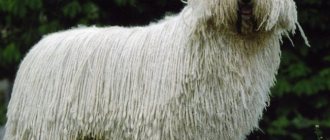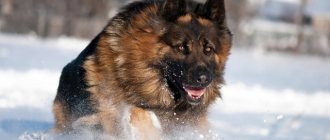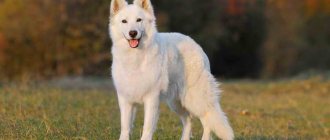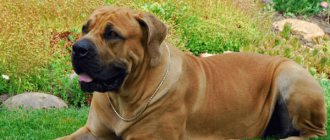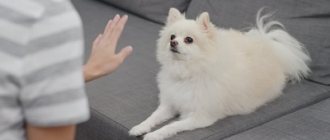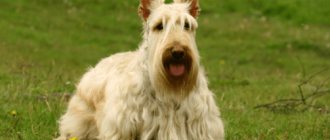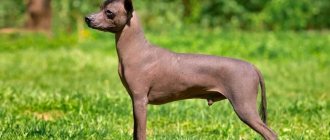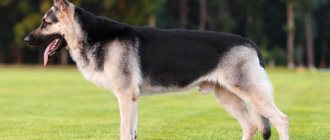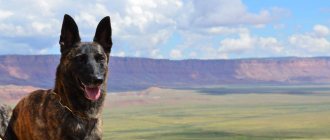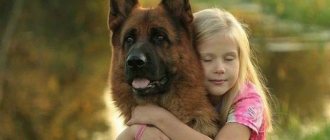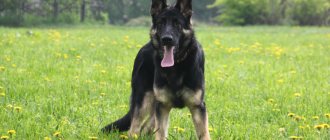Komondor (Hungarian Shepherd Dog; English Hungarian sheepdog, Hungarian Komondor) is the national pride of Hungary.
This dog has a powerful build and a completely unique coat that protects the dog’s body from any external influences.
Komondors are easy-going and easy-going, although most people treat them with some wariness.
Since ancient times, Komondors have helped people protect livestock and poultry from attacks by foxes, wolves and bears, which predetermined their “herding” specialization.
Komondors were glorified in the ancient literary works of European educators Peter Kokony (“History of King Astgias”, 1544), John Amos Comenius (1653), Ferenc Pietsch (“History of the breed and the teaching of the craft”, mid-19th century).
History of the breed
There is no reliable origin story. Although the Komondor is considered a Hungarian Shepherd, it was not bred in Hungary. One version is that it was brought by nomads from Tibet. And they called it “kuman dor”, which translates as “Polovtsian dog”. Hungary is not the country of origin, but here it is loved and considered a national treasure. The dog was used as a herd guard to drive away foxes and wolves. Currently it is an excellent watchdog.
A dog with a serious character and will obey only the leader. If you are not a leader by nature, then a dog is not for you. If the owner is an authority figure for the dog, then the Komondor will become the most faithful friend.
Nutrition
The Commander is a huge dog, but eats very little - the amount of food is 1-1.5 kg per day. Fresh water should always be freely available. In general, the Hungarian Shepherd is characterized by unpretentiousness in food.
Owners need to decide what an adult dog’s diet will consist of – dry food or natural products. Experts recommend the first option due to the balanced composition containing the required amount of minerals and vitamins.
The number of feedings depends on the age of the pet; puppies should be fed per day:
- up to 1.5 months of age - 5 times;
- up to six months of age - 4 times;
- up to one year - 3 times;
- older than a year – 2 times.
A dog's diet of natural food includes meat (beef, chicken), vegetables, dairy products (cheese, cottage cheese), cereals, and fruits. You should not offer your pet:
- fatty meat – not digestible by the stomach;
- bones - damage the stomach;
- milk – leads to indigestion;
- chocolate and other sweets cause intestinal diseases.
You can buy a special bone for sharpening teeth at a pet store.
Komondor: breed features
- Good guard qualities . They are distrustful of strangers and can be aggressive.
- Good memory . The Komondor is able to recognize a person after years.
- For maintenance in private houses . Space is needed.
- Any collar is harmful to the Komondor's coat.
- Need walks and games . The dog should splash out its energy outside.
- For experienced owners . The dog has a serious character and requires a responsible and experienced owner.
- There is no undercoat . The commander has no undercoat, only puppy fluff. Many owners cut their pet's hair, but you need to understand that dreadlocks protect it from any weather. Without them, he is defenseless and only needs to be kept at home.
- A training course is required . The Komondor requires constant training. Even a perfectly trained dog can make a different decision at any time and act on its own.
- Complicated in content.
Reviews
- Maria:
“I have been looking for a puppy of this breed for two years. We managed to purchase a dog from a Hungarian kennel after six months of negotiations. The breed is amazing, their health is simply excellent, they are hardy and nimble. Undeservedly rare! At Russian exhibitions I see them “once every five years”; in Europe there are several well-known nurseries, and things are better there. On the street they periodically call him a mongrel, which is strange to people.”
- Anastasia:
“I have a male Mudi. Before that, I kept a border collie, they are really similar in behavior, but they seem to be more reasonable and tougher. Every 2 weeks we go to herd sheep, the trainer is delighted with him, he says he has rarely seen such work. We'll start practicing PSS soon, we'll see how it shows itself there. By the way, ours is not a gibberish, he squeals when he drives a flock"
Share link:
Care and maintenance
- There is no need to comb the wool (dreadlocks). The Komondor's coat grows, sheds, and becomes dreadlocked. It is only necessary to separate the dreadlocks so that they do not tangle into one single thing during molting. She sheds twice a year in autumn and spring. When dreadlocks have already been formed in an adult dog, you can completely forget about this procedure. Wool grows until the end of life.
- The wool is not cut. Show dogs are not subject to this procedure at all, since the longer the dreadlocks, the higher the rating at the show. If the dog is not a show dog, many owners believe that a clipped dog looks and feels much better. However, we must remember that the dog has no undercoat and if you cut it, you should only keep it at home.
- Washing is also not recommended, only as needed. No more than twice a year. Grooming takes about 5-8 hours. The wool takes about two days to dry, and no compressor will help.
- Dental care. It is enough to examine the Komondor's teeth and oral cavity once a week. As for the care itself, during a thorough examination you should pay attention to: The condition of the gums - if they are red and inflamed, it is recommended to contact a veterinarian who will recommend special medications or remedies;
- Teeth color – ideally, it should remain normal, without plaque (you can clean it yourself) and purulent formations. To maintain teeth in good condition, special bones and toothpastes for dogs can be very useful;
- Dental health – check for loose or broken teeth. Between them there should also be no food residues, the accumulation of which causes the animal to develop an unpleasant odor from the mouth and subsequently rot;
- The presence of tartar - in this case, it is impossible to do without the intervention of a veterinarian and its removal. It should also be noted that an important factor for the health of the Komondor - and in particular the teeth - is proper balanced nutrition.
Remember that all dog grooming procedures help to establish a relationship with the dog and train him to be disciplined. Regular checking of the Komondor puppy will develop into a kind of mandatory and pleasant communication procedure. If you notice any changes in behavior or find any unexplained sores or redness, contact your veterinarian.
Appearance
The Mudi is a Hungarian Cattle Dog of medium size and build. The body is almost square with a slightly sloping topline from withers to croup. The head is wedge-shaped with erect ears.
The coat is short and straight on the face and front of the legs. The rest of the body is covered with very curly hair up to 7-8 cm long. Colors: white, beige (ivory), chocolate, black, harlequin (merle).
The differences between Mudi, Puli and Pumi are relatively small, but there are some significant differences.
- Firstly, the eyes: oval, dark and obliquely set, while those of the pumi and pumi are round.
- Secondly, the ears: erect, pointed, like those of a Spitz.
- Thirdly, the coat: not laced, like a bullet’s, but short or medium-length, curly. Sometimes puppies are born without a tail or with a natural "stump"; This is not considered a marriage. In general, the dog gives the impression of a curly little Spitz.
Health
The Komondor has fairly good health. However, the dog is predisposed to the following diseases.
- Hip dysplasia.
- Bloating.
- Entropy.
- Skin diseases.
- Eye diseases.
Preventive measures to protect your Komondor puppy
- To keep your Komondor puppy completely safe, you first need to minimize his contact with unfamiliar dogs, especially stray dogs. Therefore, you should not let your dog off the leash, as in this case it will become impossible to control its behavior and communication with other dogs. Since a dog can easily become infected with distemper from simply touching the nose of a sick animal. This disease can be transmitted to a dog through sniffing. Your dog can become infected with trichophytosis from contact with the lichen-affected fur of a sick dog. Naturally, it is impossible to completely exclude a dog’s communication with other dogs, since it must be socialized. Therefore, try to find friends with dog lovers who look after their animals. By adhering to this rule, you can eliminate the risk of pathogen transmission by 80%.
- You should walk your dog in places where there are no landfills. Since garbage very often attracts rodents, which in turn are very often carriers of various infections. Gray rats are especially dangerous because they carry such a serious disease as leptospirosis.
- You should not allow your dog to sniff other people's feces, as they are a source of worms.
- Monitor your Komondor's health. Pay attention to even the most minor changes in his behavior. For example, your dog may appear lethargic, lose his appetite, or have a dry nose. Or you may notice that the dog begins to shed, and this has nothing to do with seasonal shedding. If hair loss becomes excessive, this is the first symptom indicating health problems in your pet. And only you can help him. Therefore, it is important to take the dog to the veterinary clinic in time, where the disease can be overcome for sure. In no case should you ignore the symptoms, since advanced infections are much more difficult to treat, and sometimes even impossible. If you start treating your dog, the disease can lead to his death or he will develop serious complications that will affect his hearing, vision, limbs and much more.
Training and education
A training course is required . The dog has a strong and willful character and needs constant training. Even a well-trained dog can independently make a decision that will contradict the owner’s opinion. You cannot give concessions otherwise the dog will ignore commands.
Submitting a dog doesn't always work. The principle of complete submission of the Komondor to the owner is an outdated method. This theory was formulated based on observations of packs of wild wolves, but they were kept in captivity and, of course, experienced stress. The stress condition forced wolves to show aggression towards each other, but in the wild they do not show aggression to each other - they live together and interact with each other. You need to perceive yourself as the more experienced and mature member of the pack, who is responsible for guiding the new member (Komondor puppy) and teaching him good behavior, as well as correcting him if necessary. It is important to remember that Komondor puppies learn a lot on their own. They are very inquisitive, love to explore new territories and, of course, experiment. Puppies tend to repeat actions they enjoy (like playing with a toy). They do not repeat actions that cause them pain (for example, destroying a nest and getting bitten). If your Komondor puppy misbehaves, ignore him and praise him when he does the right thing. Reward your puppy for following commands and good behavior. Do not neglect these tips. After all, constantly hearing “you can’t” all day long is unbearable. This is a small child who wants to know everything and get his portion of treats as a reward for not eating your favorite rug, going to the toilet outside, bringing you a ball, and so on.
Set rules and monitor their implementation
It is worth enrolling your Komondor puppy in obedience training classes. These classes will allow you to understand exactly what actions will allow you to control your dog’s behavior. You will be able to spend more time with your puppy, establish contact and socialize around other dogs.
Adviсe
- Training a Komondor puppy should be done with the help of positive motivation; watch carefully special films about this technique. The Canine Translator film series from National Geographic is suitable.
- If you need to leave your puppy at home alone for 2 hours or more, then ask someone to come to him.
- Be sure to make an appointment with your Komondor puppy to see the vet as soon as possible. The doctor will carefully examine him and give him vaccinations that will protect him from dangerous diseases.
How to choose a puppy
- Please note that Komondor puppies' fur is not yet cord-like, but curly and fluffy. Full-fledged dreadlocks appear in Hungarian Shepherds by the age of two.
- Always inquire about the age of the manufacturers. RKF does not register offspring from Komondor bitches who are under 18 months old.
- Typically, male Hungarian Shepherds have a more severe character and are less capable of training than females. For herding and protecting the territory, it is recommended to choose a male animal.
- Carefully inspect your puppy's tail. A congenital bend in this part of the body is sometimes confused with such an exterior defect as a kink. To make sure that this is not a defective baby, try to straighten the “curl” - this is usually easy to do. In addition, the correct bend will often straighten out on its own when the puppy sleeps.
- Thin or overly plump Komondor babies are not considered an enviable acquisition. It is optimal when the puppy is in moderate condition.
- Place your palm in a horizontal position (fingers forward) and try to insert it into the space between the Hungarian Shepherd puppy's front legs. If the hand does not fit, the placement of the limbs is too narrow, which is considered a defect in the exterior.
Attitude towards children and pets
They treat all family members with tolerance.
- They get along well and protect all family members. But this is not a nanny and it is better not to leave a small child alone with a dog.
- Loyal to other pets.
If you decide to get a dog, especially a puppy, then get ready for the following: you will often have to clean up little mistakes after the puppy; investments will be required in annual vaccinations, feeding, toys, ammunition, etc.; any animal requires attention and communication, so if you don’t have time, then there will be no mutual understanding with the Komondor puppy. Big changes are coming in your life. If you can handle this, you will find a loyal friend for life.
